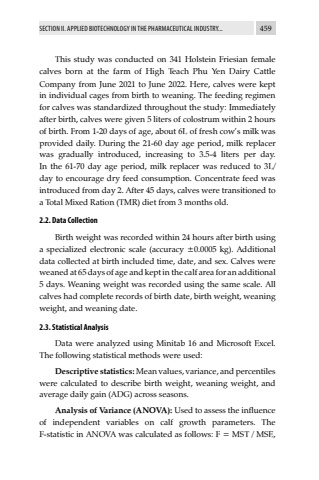Page 455 - Demo
P. 455
SECTION II. APPLIED BIOTECHNOLOGY IN THE PHARMACEUTICAL INDUSTRY... 459This study was conducted on 341 Holstein Friesian female calves born at the farm of High Teach Phu Yen Dairy Cattle Company from June 2021 to June 2022. Here, calves were kept in individual cages from birth to weaning. The feeding regimen for calves was standardized throughout the study: Immediately after birth, calves were given 5 liters of colostrum within 2 hours of birth. From 1-20 days of age, about 6L of fresh cow%u2019s milk was provided daily. During the 21-60 day age period, milk replacer was gradually introduced, increasing to 3.5-4 liters per day. In the 61-70 day age period, milk replacer was reduced to 3L/day to encourage dry feed consumption. Concentrate feed was introduced from day 2. After 45 days, calves were transitioned to a Total Mixed Ration (TMR) diet from 3 months old.2.2. Data CollectionBirth weight was recorded within 24 hours after birth using a specialized electronic scale (accuracy %u00b10.0005 kg). Additional data collected at birth included time, date, and sex. Calves were weaned at 65 days of age and kept in the calf area for an additional 5 days. Weaning weight was recorded using the same scale. All calves had complete records of birth date, birth weight, weaning weight, and weaning date.2.3. Statistical AnalysisData were analyzed using Minitab 16 and Microsoft Excel. The following statistical methods were used:Descriptive statistics: Mean values, variance, and percentiles were calculated to describe birth weight, weaning weight, and average daily gain (ADG) across seasons.Analysis of Variance (ANOVA): Used to assess the influence of independent variables on calf growth parameters. The F-statistic in ANOVA was calculated as follows: F = MST / MSE,


